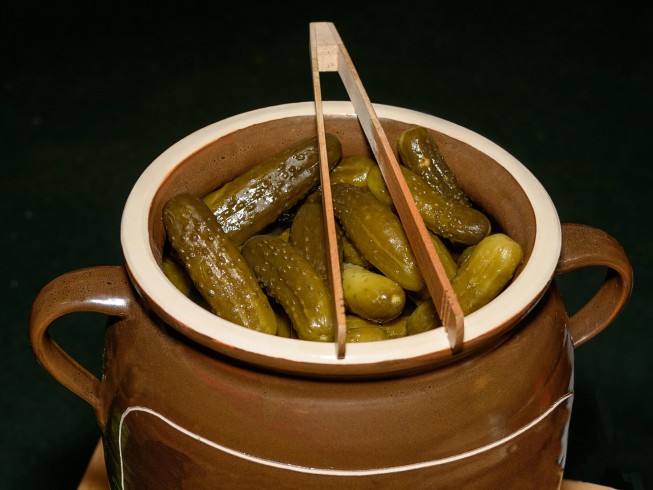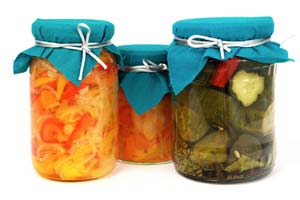If you're a fan of the menu at this American chain of restaurants which serves a variety of foods such as burgers, steaks, pasta, and seafood then you'll love this collection of copycat recipes.

These pickles are the real deal, made from cucumbers that are hand-selected and barrel-cured for weeks. They're perfect for snacking or adding some crunch to your favorite sandwich.

5 pounds pickling cucumbers (about 4-inch size)
4 tablespoons pickling spices
6 bunches dill, washed and chopped
6 cloves garlic, peeled and crushed, more if desired
1 cup white vinegar
2/3 cup pickling salt
1/2 teaspoon powdered alum
2 quarts water
Rinse the cucumbers and let dry.
Place half of the pickling spices, dill, and garlic in the bottom of a large stoneware crock or other non-reactive container. Layer the cucumbers in the crock, leaving 3-inches of space at the top.
Top the cucumbers with the remaining pickling spices, dill, and garlic.
Combine the vinegar, pickling salt, alum, and water in a large container. Mix well. Slowly pour the mixture over the cucumbers, making sure they are fully covered. If, for some reason, they are not fully covered, make more of the bring mixture to add to the crock. They MUST be fully submerged.
Place a non-reactive plate over the cucumbers. Add a weight (also non-reactive) such as stoneware or a brick, so the pickles stay submerged.
Cover the top of the crock loosely with cheesecloth or a tea towel (air must be allowed to get in).
Check the pickles daily and remove any scum that forms on the top. Add more brine if needed. After 3-4 weeks, taste the pickles. If they need more fermenting, let sit for up to another month (adding or replacing the brine as needed).
Store the fully fermented pickles in a cool location or in the refrigerator for 4-6 months.
If you don't have alum you can use 8 grape leaves instead.
For the crispest pickles, make sure the cucumbers are fresh and not overly ripe. Smaller, firm cucumbers are ideal.
Keep the fermentation container in a cool, dark place to maintain consistent fermenting conditions.
Tasting the pickles periodically after the first few weeks can help you decide when they've reached your preferred level of sourness.
If foam or scum forms on the surface of the brine, it's a normal part of the fermentation process. Just skim it off and make sure the cucumbers remain submerged.
Once the pickles have reached your desired level of fermentation, transferring them to smaller jars with fresh brine can extend their shelf life and make them easier to store in the refrigerator.
It's best to use pickling cucumbers for their size, texture, and ability to absorb flavors. Regular cucumbers may result in softer pickles due to their higher water content.
A large glass jar or food-grade plastic container can be used as an alternative to a crock. Make sure it's large enough to hold the cucumbers and brine while allowing space for a weight to keep the cucumbers submerged.
Alum is used to help keep the pickles crisp, but it is optional. Grape leaves are a natural alternative that also helps maintain crispness due to their tannin content.
Feel free to customize the pickling spices according to your taste. Adding extra garlic, bay leaves, mustard seeds, or hot peppers can create unique flavor combinations.
If you notice an off smell, mold growth on the surface of the brine, or if the pickles have become soft and discolored, they may have spoiled and should not be consumed.
The fermenting process depends largely on the temperature and conditions where the pickles are stored. Warmer temperatures can speed up fermentation, but for the best flavor development, patience is key.
Yes, the recipe can be scaled down to make a smaller batch. Just make sure the brine covers the cucumbers completely in a smaller non-reactive container.
If you're a fan of the menu at this American chain of restaurants which serves a variety of foods such as burgers, steaks, pasta, and seafood then you'll love this collection of copycat recipes.
The name, vodka, comes from the Russian phrase zhiznennaia voda, or "water of life". It can be made from everything from potatoes to beets. It's considered to be fairly flavorless which makes it a great liquor for mixed drinks.
Love the spinach dip at restaurants like TGIFriday's and the Olive Garden? Make it at home with these easy-to-follow copycat recipes.

Online since 1995, CDKitchen has grown into a large collection of delicious recipes created by home cooks and professional chefs from around the world. We are all about tasty treats, good eats, and fun food. Join our community of 200K+ members - browse for a recipe, submit your own, add a review, or upload a recipe photo.

reviews & comments
I remember the old country stores walking in and there wa huge wooden barrel of these pickles, I canât wait to make these. My 3 grandchildren love the jar pickles from the store thus a jar will be lucky to make it to the 3rd day. They love that sour taste and will actually drink the juice when the pickles are gone. Will this recipe produce that same sour taste as I see it calls for vinegar?
These are fermented pickles so they will have a sour taste. Let us know how they turn out!
Can I add additional cucumbers to those already in the crock or do I have to create a separate batch?
You'll want to start a fresh batch
I just made 10 lbs but. Donât know if they should be at room temperature or in my garage in this first stage? Please respond thank you,
The best location would be a cool, dark place such as a basement. You don't want it too warm where they are stored.
September 24, 2020
First time using this recipe, it reminded me of my dad's crock dill pickles that I grew up on. He's 93 years old and forgot his recipe. The reason for the 1 star: NO TASTE of dill, garlic or pickling spice. VERY SALTY. CRISPNESS is good. I won't be giving up on making crock dill pickles. Next year I'll be making adjustments to this recipe until I'm able to match my dad's crock dill pickles.
That's weird. We've always had plenty of flavor to them.
August 12, 2020
This is a great recipe. I used Persian pickles for this. I was fortunate that no scum formed even with using alum. Skin was crispy inside loaded with brine. I did add a few extras cloves of garlic. You can add too much
I haven't made this exact recipe before, but it is a great recipe. My only change is I don't use grape leaves or alum. If these pickles are too salty for you, there are 2 things to think about. Either 1) fermented pickles aren't for you & you should make vinegar-based pickles or 2) you kept too little air from getting to the brined pickles and they didn't ferment. The sour flavor should take over for the saltiness when they're done right. Also, do not try these with less salt. This salt level is needed to help kill off bad bacteria and promote the good bacteria that ferment it.
October 22, 2016
It,s been 4 weeks. I tried one and it was very salty. I'm not complaining I will try again. My question is, how do I store them now? Can they be canned? how long will they keep? Is their a way to reduce the salt flavor in this current batch? Thank You
I didn't have cheesecloth so I used a kitchen towel. Is that enough air to get in?
I think that should work ok
can you put the crock pot cover on instead of cheesecloth?
The cheesecloth is so the mixture can get air. You do not want to cover it with an actual cover.
August 30, 2015
Wanted to let you know my pickles turned out great in the bucket but never had any scum to remove. Was wanting you're opinion on how long they are good for? Is it ok to transfer to jars? Thx
Thanks you I hope it works I will let you know
August 11, 2015
I made this pickle recipe in a five gallon plastic bucket. Will this make a difference?
The research I did seems to indicate that if the bucket is food grade plastic then it should work ok.
August 4, 2015
Made these about 6 weeks ago. Couldn't wait to try them so I cut one up today. My opinion is they are to salty. Wish there was a way to fix this in this bunch of pickles.
June 28, 2015
this recipe is really great ihave made these several times and they have turned out great. was just wondering what the best way is to jar can these after they are ready?
November 4, 2013
Great recipe! I only made one pound as a test batch and they turned out really well. We just tried them now after letting them sit for two months. That was the hardest part - waiting!
July 28, 2013
This was our first attempt at homemade pickles. They had a pretty good crunch to them and good flavor. Does anyone know if this will work for pickling other vegetables too like carrots and cauliflower? I'd like to make a pickled veggie blend but not sure if this same method is appropriate or not. Also, I'd never heard of grape leaves as an alternate to alum so I found that really interesting. Learn something new every day!
August 26, 2012
Very good recipe, fool proof works every time. I scaled back to 3 lbs and the end product was excellent. One time without garlic for a traditional dill pickle and it turned out perfect. Pickles turned out crisp every time.